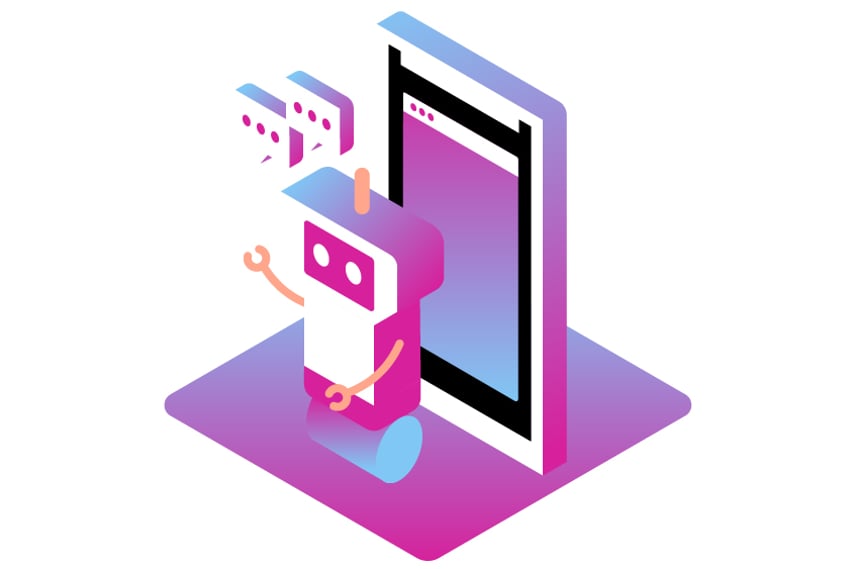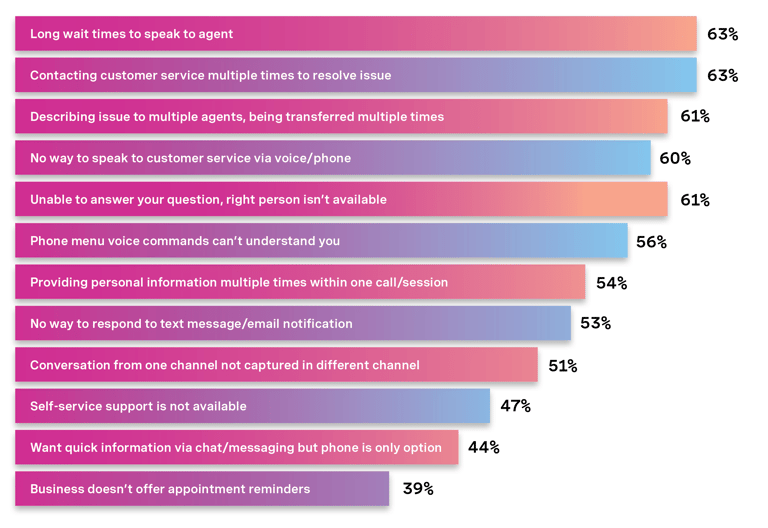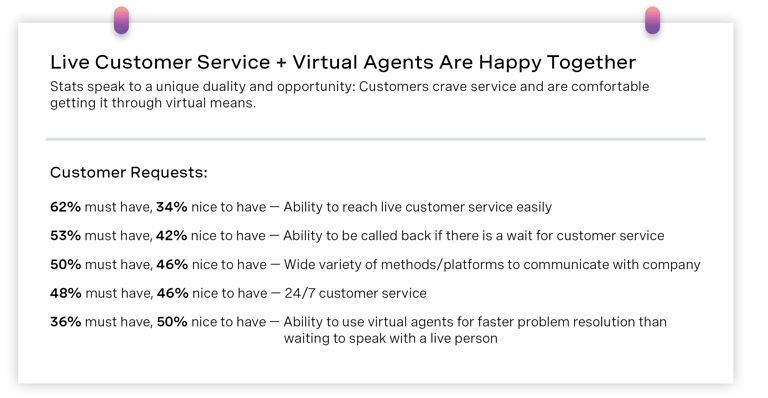10 Chatbot Benefits: How Bots Improve Day-to-Day Business Operations
Chatbot technology has come a long way. Old-school chatbots had to be scripted; they could answer basic questions, but only if the writers had anticipated them and prepared a response — and only if users had included the right keywords. Modern chatbots are powered by artificial intelligence (AI), unscripted, and capable of far more than simple Q&A. They're more like virtual assistants that can interact intelligently with your customers and employees to improve your customer experience and streamline your business. Let’s look at the top 10 chatbot benefits that can improve your day-to-day operations.

-
1.
-
2.
-
3.
-
4.
-
5.
-
6.
-
7.
-
8.
-
9.
-
10.
1. Meet Growing Customer Demand for Instant Messaging
One of the most basic business operations is interacting with customers. Chatbots aren't just the future of customer communication — they are the present.
In the Vonage Global Customer Engagement Report 2022 — drawn from a comprehensive survey of 4,638 customers around the world — we found that consumers are chatting with brands more than ever. Currently, 41% message businesses via WhatsApp, 31% via Facebook Messenger, and 26% via Instagram. One-third of consumers message brands daily, and 32% plan to chat with brands more frequently in the next six to 12 months.
We also learned that 44% of customers get frustrated when they want to chat with a brand online but a phone call is the only option. So not only are customers ready to chat, they expect brands to meet them on their preferred channel. Chatbots ensure a brand representative is always available. They can engage customers on any channel, recognize existing customers and personalize the experience, and pass the user to a live representative whenever the customer decides they'd rather speak to a human.
2. Reduce Wait Times and Customer Frustration
We asked consumers about their frustrations with businesses. The top responses included long wait times (63%), issues not being resolved in one interaction (63%), and having to repeat themselves (61%). Chatbots help businesses avoid all three of these customer communication pitfalls.
Chatbots let customers skip the queue and get instant answers and support. AI-enhanced bots can answer more than basic questions. With the right integrations, business chatbots can provide details about products, orders, and customer accounts. If the bot can't resolve an issue, it can use the information it has gathered to determine which human representative is best suited to help the customer, connect the customer to that person, and share all the information it has already gathered. This way, your agent is ready to help, and the customer doesn't have to repeat themselves.
Top Frustrations Reported by GCER Respondents

3. Deliver a Personalized, Omnichannel Customer Experience
Customers communicate with your brand across a variety of channels, and they expect you to recognize them no matter how or where they reach out. In fact, 51% of survey respondents for the Global Customer Engagement Report told us they get frustrated when the information they share on one channel hasn't been captured for the next step.
AI chatbots integrate data from all your channels, along with customer purchase history and other internal data, to deliver conversational commerce. No matter how a customer reaches out, your bot knows who they are, what they've told you, what they've purchased, and what they've viewed but haven't bought. Chatbots can use this information to better serve customers, recommend content and products, and generate personalized marketing messages across channels.
4. Provide 24/7 Customer Service
Nearly half (48%) of survey respondents told us 24/7 customer service is a must-have for modern businesses. Almost the same amount said it was a "nice to have." That doesn't mean customers expect your representatives to work around the clock; it means they're willing to chat with bots if it means they can reach out at midnight and get an immediate response.

5. Enable Self-Service and Checkout Via Chatbot
It's increasingly in your interest to help your customers help themselves. Not only does this reduce work for your team, but many customers prefer to complete sales and other interactions without assistance — nearly half (47%) get frustrated when self-service is not available.
Using chatbots, you can let customers complete their own purchases, open their own accounts, schedule their own appointments and deliveries, and make their own reservations. The chatbot simplifies the process by walking them through it step by step (or question by question), without having to wait on a human to help. In a challenging economic environment with labor shortages, these types of intelligent automated solutions allow you to maintain high levels of customer service while controlling costs.
6. Improve Your Conversion Rate
Bots can boost your conversion rate by improving your conversation rate. Rather than asking prospects to fill out forms expressing their interest, chatbots can engage them in a discussion about their needs and challenges and where they are in the buying process. Then the bot can guide them through the customer journey, nurturing the prospect by suggesting relevant content or making personalized product recommendations.
Then the chatbot can pass the now-qualified prospect along to the customer resource management system or set an appointment with a human rep to seal the deal.
7. Reduce Customer Service Costs
Implementing a chatbot for business optimizes customer service and drives down costs. Chatbots are expected to save companies roughly $11 billion in 2023, according to Juniper Research, up from $6 billion in 2018.
When you invest in chatbots, you save funds that would have been spent hiring and training additional human representatives. While your chatbots handle simple issues and provide self-service to customers who want it, your people can focus on helping customers with more complex needs and on growing the business.
8. Notify Customers
Bots can keep on top of many of the small interactions that can make a difference to customers but can sometimes be overlooked during a busy day. This includes keeping your customers in the loop with delivery notifications, status updates on orders, appointment reminders, personalized sales offers, and anything else you want them to know. Most customers appreciate timely, relevant notifications, and 39% of survey respondents in the Global Customer Engagement Report told us they get frustrated with businesses that don't offer appointment reminders.
Unlike traditional SMS notifications, bot-generated communications aren't one-way communications. Customers can respond with questions or concerns, which is important, considering 53% told us one of their top frustrations was not being able to respond to text or email notifications.
9. Scale Customer Support
One challenge for many businesses is getting the right ratio of representatives to customers. While it may be easier to plan based on a "normal" day, it can be tough to get the ratio right during peak times, like holidays or sales. This is another area where chatbots can improve your operations.
AI-powered bots can help thousands of customers at once, providing immediate support. This gives you the ability to easily and quickly scale your customer support capacity without scaling costs. When traffic surges during the holidays, big sales, or peak hours, your bots are there to back up your people.
This reduces the need to hire and train seasonal help and cuts the likelihood of rostering too many staff during quiet times.
10. Automate Routine Business Processes
Chatbot benefits extend beyond customer service and communication. They can also help streamline internal communication and processes. For example, chatbots can onboard new employees by helping them fill out forms, walking them through the employee handbook, and delivering training resources.
Chatbots can also automate many HR functions by letting employees check their schedules and request time off, provide tech support, and answer questions about insurance and other employment benefits.
How Do You Start Using Chatbots?
Modern chatbots are increasingly sophisticated, but they're also easier to implement than their predecessors. You don't need to write a script or program an AI-powered bot. Vonage offers a Chatbot Builder that lets you add conversational AI to your website, mobile app, and other online properties. You can build bots to help you qualify leads, drive customer engagement, close sales, provide customer support, and have one-to-one conversations with your customers at scale.
The Vonage conversational commerce platform features tools to help incorporate chatbots as part of a broader strategy to engage your customers anytime, anywhere. Our multichannel chatbot automation solutions are easy to implement and can work across WhatsApp, Facebook Messenger, and other leading messaging platforms.
Simply put: You get all the chatbot benefits without having to reinvent the wheel. Just plug and play, and let the conversational commerce begin.
And if you have more complex requirements, Vonage communications APIs can help you build a customized solution.
Download the Vonage Global Customer Engagement Report 2022 to learn more about what customers want from modern brands and how chatbots can help you deliver it.
